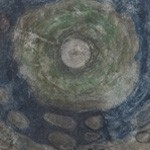
1988
wood, hog hide, steel, theatrical makeup, paper, bone, ink, plastic
66 x 70 x 67 inches
Commentary on the 1959 Chinese takeover of Tibet with a covert reference to the Central Intelligence Agency involvement.
Made after Chin read an article on police brutality in Tibet, The Opera of Silence consists of an oversized replica of a Beijing Opera drum propped on a post like a simple animal snare. In 1959 a Tibetan rebellion was brutally crushed by the Chinese army. The CIA is believed to have trained the Tibetan rebels but steadfastly denied any role in the uprising. The post propping up the drum is made from two traditional Tibetan implements: a trumpet fashioned from a human thighbone, used in tantric rituals to remind participants of impermanence and death, and a skeleton-head staff—symbolic of absolute reality—which is the attribute of the Lord of Death. The stitching of the hog hides that cover the drum traces the outline of the CIA’s official seal. The back of the drum is smeared with white theatrical makeup, which in the conventions of the Beijing Opera signifies treachery. Both the drum and the trumpet have been rendered useless by the staff wedged between them, their silence symbolizing both the suppression of a people and the official silence in Beijing and Washington.










